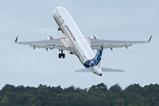A faulty fan unit likely contributed to a brake fire and a “huge screen of smoke” that trailed a Frontier Airlines-operated Airbus A321 upon landing in Las Vegas earlier this month.
That is according to a 28 October preliminary report by the US National Transportation Safety Board (NTSB), which details investigators’ findings of the 5 October incident at Harry Reid International airport.
Operating as flight 1326 from San Diego, the A321’s pilots were alerted by flight attendants to an unusual smell in the forward section of the aircraft as they prepared to descend into Las Vegas.
”The cabin crew described the odour as a chemical smell that was difficult to identify, and were unable to determine its source,” the NTSB says. ”Shortly thereafter, the captain and first officer detected an odour in the cockpit, which they initially described as chemical and acrid in nature, or mildew-like.”

Soon, the smell became stronger and resembled ”burning rubber and/or petroleum products, such as plastics”, the pilots said.
Donning oxygen masks, the pilots initiated a check-list in their quick reference handbook (QRH), noting that no smoke was visible in the cockpit and confirming with flight attendants that smoke was not visible within the cabin, though the “odour persisted”.
At 14:51 Las Vegas time, the first officer declared an emergency with air traffic control (ATC) and requested a descent into Las Vegas.
Aircraft systems degraded as the pilots proceeded through their QRH check-list, as they noticed autopilot and autothrottle features became unavailable. The first officer later said it was unclear whether these losses were the result of a possible fire or systems isolations performed as part of the check-list.
The QRH advised an electrical emergency configuration procedure if “smoke/fumes were the greatest threat” or if “the source of the smoke/fume could not be determined”.
“Because he was unable to determine the source of the odour, the captain, confirming with the first officer, elected to perform” the electrical emergency configuration procedure, which would deploy the ram air turbine – which can be used as a back-up power source in emergencies.
As a result of the procedure, initiated at 15:01, the display screens, radio and transponder stopped functioning on the first officer’s side of the flight deck, and the flight data recorder lost power.
With the first officer’s radios down, the pilots had some difficulty communicating with ATC. The first officer noted that the airspeed indicator was not present on the instrument panel, and the captain’s primary flight screen had “limited data presented”.
“The crew described their workload as high and the environment as increasingly hectic and stressful,” the NTSB says. “The captain opted to focus on landing the airplane and relied on outside visual references during the approach. The first officer acknowledged ATC communications and instructions and confirmed/reiterated them with the captain, while calling out airspeeds, altitudes and configuration information.”
When the aircraft touched down on runway 26L at 15:10, the captain moved thrust levers into full reverse and applied brakes. He later recalled that the aircraft “had no auto-brakes and felt like no anti-skid”.
A witness on the ground recalled “two loud bangs in quick succession as the tires exploded about three seconds after touchdown. Then there was a large screen of smoke behind them and fire around the tires”.
The pilot struggled to maintain the runway centreline, with the aircraft veering as it lost speed.
Smoke trailed behind both main landing gears before flames appeared. Firefighters sprayed extinguishing agent around the landing gear and engines when the aircraft stopped moving and assured the cabin crew by radio that the smoke and flames were no longer a threat.
Of seven crew members and 190 passengers, none reported injuries, and all deplaned via stairs before being bussed to the terminal.
Damage was limited to the nine-year-old A321’s landing gear, wheels, tired and brakes, and is therefore “not considered to be substantial”, the NTSB says.
Data recovered from the aircraft indicate that a fault was detected in a fan unit that cools the avionics compartment around the time that flight crew reported the unusual smell. That unit was retained for examination, while the flight data and cockpit voice recorder were sent to the NTSB’s vehicle recorder laboratory in Washington, DC.































